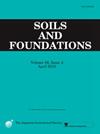Estimating S-wave velocity profiles from horizontal-to-vertical spectral ratios based on deep learning
IF 3.3
2区 工程技术
Q2 ENGINEERING, GEOLOGICAL
引用次数: 0
Abstract
S-wave velocity (Vs) profile or time averaged Vs to 30 m depth (VS30) is indispensable information to estimate the local site amplification of ground motion from earthquakes. We use a horizontal-to-vertical spectral ratio (H/V) of seismic ambient noise to estimate the Vs profiles or VS30. The measurement of H/V is easier, compared to active surface wave methods (MASW) or microtremor array measurements (MAM). The inversion of H/V is non-unique and it is impossible to obtain unique Vs profiles. We apply deep learning to estimate the Vs profile from H/V together with other information including site coordinates, deep bedrock depths, and geomorphological classification. The pairs of H/V spectra (input layer) and Vs profiles (output layer) are used as training data. An input layer consists of an observed H/V spectrum, site coordinates, deep bedrock depths, and geomorphological classification, and an output layer is a velocity profile. We applied the method to the South Kanto Plain, Japan. We measured MASW, MAM and H/V at approximately 2300 sites. The pairs of H/V spectrum together with their coordinates, geomorphological classification etc. and Vs profile obtained from the inversion of dispersion curve and H/V, compose the training data. A trained neural network predicts Vs profiles from the observed H/V spectra with other information. Predicted Vs profiles and their VS30 are reasonably consistent with true Vs profiles and their VS30. The results implied that the deep learning could estimate Vs profile from H/V together with other information.
基于深度学习的水平-垂直频谱比估算 S 波速度剖面
S 波速度(Vs)剖面或 30 米深度的时间平均 Vs(VS30)是估算地震引起的地面运动的局部场地放大效应不可或缺的信息。我们使用地震环境噪声的水平-垂直频谱比(H/V)来估算 Vs 剖面或 VS30。与主动表面波方法(MASW)或微震源阵列测量(MAM)相比,H/V 的测量更为简单。H/V 的反演是非唯一的,因此不可能获得唯一的 Vs 剖面。我们采用深度学习方法,从 H/V 和其他信息(包括站点坐标、深基岩深度和地貌分类)中估算 Vs 剖面。H/V 光谱(输入层)和 Vs 剖面(输出层)对作为训练数据。输入层包括观测到的 H/V 光谱、站点坐标、深基岩深度和地貌分类,输出层为速度剖面。我们将该方法应用于日本南关东平原。我们在大约 2300 个地点测量了 MASW、MAM 和 H/V。H/V频谱对及其坐标、地貌分类等以及通过反演频散曲线和H/V获得的Vs剖面构成了训练数据。经过训练的神经网络根据观测到的 H/V 光谱和其他信息预测 Vs 剖面。预测的 Vs 曲线及其 VS30 与真实的 Vs 曲线及其 VS30 基本一致。这些结果表明,深度学习可以根据 H/V 和其他信息来估计 Vs 曲线。
本文章由计算机程序翻译,如有差异,请以英文原文为准。
求助全文
约1分钟内获得全文
求助全文
来源期刊

Soils and Foundations
工程技术-地球科学综合
CiteScore
6.40
自引率
8.10%
发文量
99
审稿时长
5 months
期刊介绍:
Soils and Foundations is one of the leading journals in the field of soil mechanics and geotechnical engineering. It is the official journal of the Japanese Geotechnical Society (JGS)., The journal publishes a variety of original research paper, technical reports, technical notes, as well as the state-of-the-art reports upon invitation by the Editor, in the fields of soil and rock mechanics, geotechnical engineering, and environmental geotechnics. Since the publication of Volume 1, No.1 issue in June 1960, Soils and Foundations will celebrate the 60th anniversary in the year of 2020.
Soils and Foundations welcomes theoretical as well as practical work associated with the aforementioned field(s). Case studies that describe the original and interdisciplinary work applicable to geotechnical engineering are particularly encouraged. Discussions to each of the published articles are also welcomed in order to provide an avenue in which opinions of peers may be fed back or exchanged. In providing latest expertise on a specific topic, one issue out of six per year on average was allocated to include selected papers from the International Symposia which were held in Japan as well as overseas.
 求助内容:
求助内容: 应助结果提醒方式:
应助结果提醒方式:


